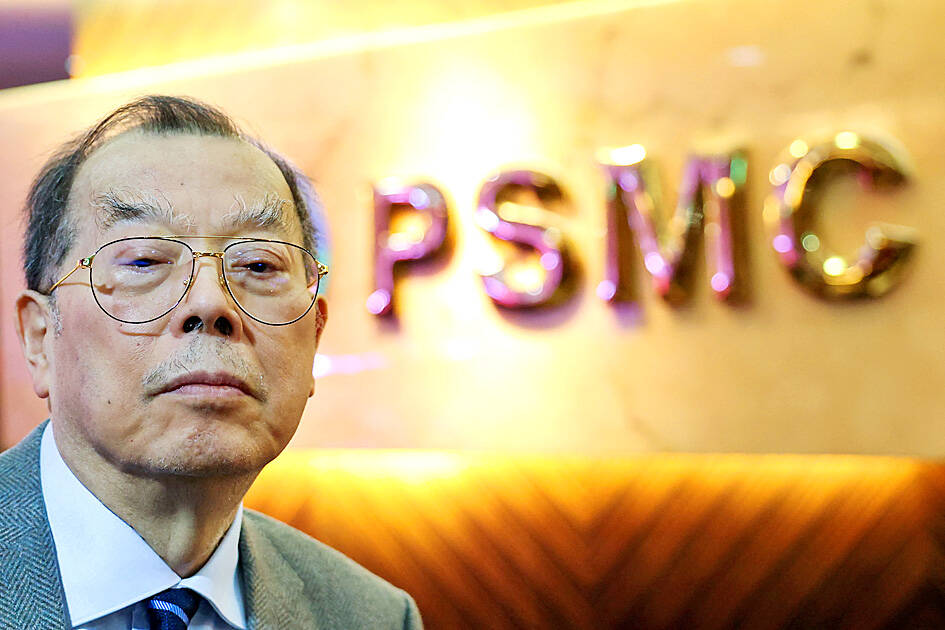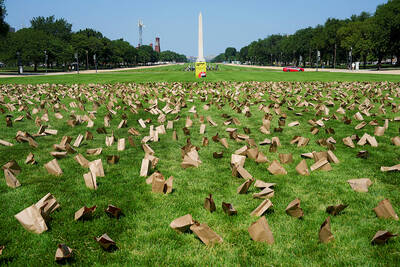When Powerchip Technology Corp (力晶科技) entered a deal with the eastern Chinese city of Hefei in 2015 to set up a new chip foundry, it hoped the move would help provide better access to the promising Chinese market.
However, nine years later, that Chinese foundry, Nexchip Semiconductor Corp (合晶集成), has become one of its biggest rivals in the legacy chip space, leveraging steep discounts after Beijing’s localization call forced Powerchip to give up the once-lucrative business making integrated circuits for Chinese flat panels.
Nexchip is among Chinese foundries quickly winning market share in the crucial US$56.3 billion industry of so-called legacy or mature node chips made on 28-nanometer process technology and larger, a trend that prompted former US president Joe Biden’s administration to initiate an investigation and is alarming Taiwanese industry.

Photo: Ann Wang, Reuters
These Chinese foundries, which include Hua Hong Semiconductor Ltd (華虹半導體) and Semiconductor Manufacturing International Corp (SMIC, 中芯國際), are threatening the long-held dominance of Powerchip, United Microelectronics Corp (UMC, 聯電) and Vanguard International Semiconductor Corp (世界先進) in the market for chips used in cars and display panels by slashing prices and embarking on aggressive capacity expansion plans.
Taiwanese foundries are then forced to retreat or pursue more advanced and specialty processes, executives in Taiwan said.
“Mature-node foundries like us must transform; otherwise, Chinese price cuts will mess us up even further,” said Frank Huang (黃崇仁), chairman of Powerchip Investment Holding Corp (力晶創新投資控股) and its listed unit Powerchip Manufacturing Semiconductor Corp (力積電), which the company was reorganized into in 2019.
UMC said that the expansion of capacity globally had created “severe challenges” for the industry and that it was working with Intel to develop more advanced, smaller chips and diversify beyond legacy chipmaking.
US-China trade tensions might ease the pain a bit, executives in Taiwan said, as companies hoping to secure supply chains seek chips made outside China. However, US President Donald Trump has said he plans to impose tariffs as high as 100 percent on semiconductors made outside the US.
Blocked by the US in recent years from pursuing high-end chip technology, Chinese foundries doubled down on legacy chips and have undercut Taiwanese rivals on price, because of strong funding support from Beijing and their embrace of lower margins, executives in Taiwan said.
Chinese companies have dramatically increased legacy chip production capacity in the past few years.
China’s share of global mature node manufacturing capacity was 34 percent last year, while Taiwan’s was 43 percent, Taipei-based TrendForce Corp (集邦科技) said.
By 2027, China’s share is projected to surpass Taiwan’s, while South Korea and the US, with single-digit shares, are expected to decline.
Consultancy SEMI forecasts that out of 97 new fabrication plants starting production from 2023 to this year, 57 are in China.
Although Taiwanese foundries can still compete on factors such as process stability and better production yields, one executive working at a Taiwanese chip designer said Chinese foundries had since 2023 become more aggressive in pitching business.
That person, and a second one working at another Taiwanese chip designer, said Chinese customers — especially in consumer-focused sectors such as panels — were increasingly asking Taiwanese chip designers to hire Chinese fabs to make the chips, in line with a call from Beijing for Chinese companies to localize supply chains.
Some respite could come from efforts by Washington to curb China’s chip industry growth, alongside worsening relations between Beijing and other countries that force customers to split supply chains into China-for-China and non-China networks.
Huang said they were already seeing some orders that would have gone to China being directed to their sites in Taiwan and expect that to accelerate. An executive from a chip design company in Taiwan also said they had been receiving more orders from international customers asking to make chips outside China since 2023.
“Some customers will tell us that no matter what, they don’t want us to tape out chips in China; they don’t want ‘Made in China,’” the executive said.

Nvidia Corp chief executive officer Jensen Huang (黃仁勳) on Monday introduced the company’s latest supercomputer platform, featuring six new chips made by Taiwan Semiconductor Manufacturing Co (TSMC, 台積電), saying that it is now “in full production.” “If Vera Rubin is going to be in time for this year, it must be in production by now, and so, today I can tell you that Vera Rubin is in full production,” Huang said during his keynote speech at CES in Las Vegas. The rollout of six concurrent chips for Vera Rubin — the company’s next-generation artificial intelligence (AI) computing platform — marks a strategic

Enhanced tax credits that have helped reduce the cost of health insurance for the vast majority of US Affordable Care Act enrollees expired on Jan.1, cementing higher health costs for millions of Americans at the start of the new year. Democrats forced a 43-day US government shutdown over the issue. Moderate Republicans called for a solution to save their political aspirations this year. US President Donald Trump floated a way out, only to back off after conservative backlash. In the end, no one’s efforts were enough to save the subsidies before their expiration date. A US House of Representatives vote

REVENUE PERFORMANCE: Cloud and network products, and electronic components saw strong increases, while smart consumer electronics and computing products fell Hon Hai Precision Industry Co (鴻海精密) yesterday posted 26.51 percent quarterly growth in revenue for last quarter to NT$2.6 trillion (US$82.44 billion), the strongest on record for the period and above expectations, but the company forecast a slight revenue dip this quarter due to seasonal factors. On an annual basis, revenue last quarter grew 22.07 percent, the company said. Analysts on average estimated about NT$2.4 trillion increase. Hon Hai, which assembles servers for Nvidia Corp and iPhones for Apple Inc, is expanding its capacity in the US, adding artificial intelligence (AI) server production in Wisconsin and Texas, where it operates established campuses. This

US President Donald Trump on Friday blocked US photonics firm HieFo Corp’s US$3 million acquisition of assets in New Jersey-based aerospace and defense specialist Emcore Corp, citing national security and China-related concerns. In an order released by the White House, Trump said HieFo was “controlled by a citizen of the People’s Republic of China” and that its 2024 acquisition of Emcore’s businesses led the US president to believe that it might “take action that threatens to impair the national security of the United States.” The order did not name the person or detail Trump’s concerns. “The Transaction is hereby prohibited,”